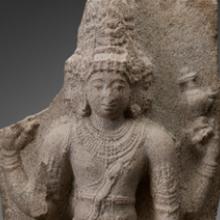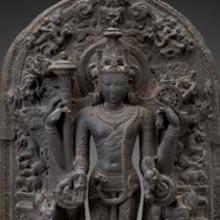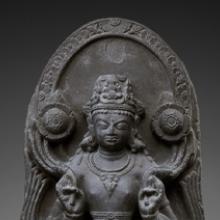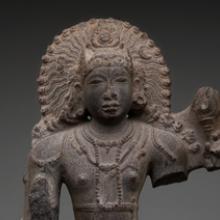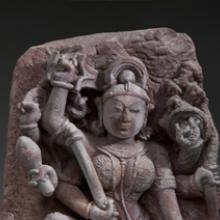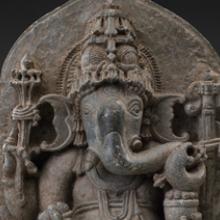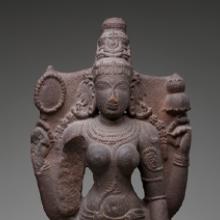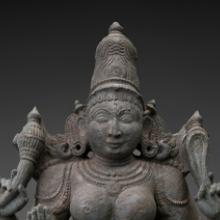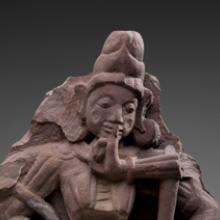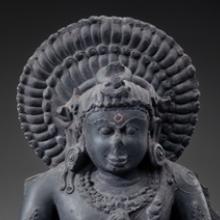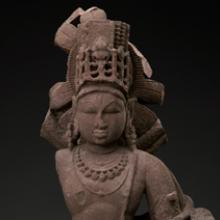Terminal 3












The Hindu deity Brahma c. 1000–1200
India; Tamil Nadu state
granite
Asian Art Museum of San Francisco, the Avery Brundage Collection
B60S46+
L2012.0801.001
 Brahma is identifiable by his four heads (one is understood to be in back). Though he is in theory a very important god, and sometimes called the creator of all beings, Brahma has few worshipers and few temples devoted to him. This image would probably have been placed in a niche in the outer wall of a temple to Shiva or Vishnu. Many stone sculptures like this one made in the Chola kingdom of southeastern India have an appealing quality of softness. This is largely because of the texture of their usual material, granite, which is coarse-grained and does not accept sharp and minutely detailed carving.
Brahma is identifiable by his four heads (one is understood to be in back). Though he is in theory a very important god, and sometimes called the creator of all beings, Brahma has few worshipers and few temples devoted to him. This image would probably have been placed in a niche in the outer wall of a temple to Shiva or Vishnu. Many stone sculptures like this one made in the Chola kingdom of southeastern India have an appealing quality of softness. This is largely because of the texture of their usual material, granite, which is coarse-grained and does not accept sharp and minutely detailed carving.
The Hindu deity Vishnu with Lakshmi and Sarasvati c. 1100–1200
Bangladesh; Dhaka District
stone
Asian Art Museum of San Francisco, the Avery Brundage Collection B60S48+
L2012.0801.003
 Vishnu is one of the most important Hindu deities. He is associated with the maintenance of rightful order in the world. When negative forces threaten this order, he descends to earth in one form or another to overcome the negative force. The forms he takes include fantastic creatures, such as a man-lion, as well as human forms, such as the hero deities Rama and Krishna. Vishnu is shown with four arms symbolizing his superhuman power. He holds implements usually associated with him: a club, war discus, and a conch shell.
Vishnu is one of the most important Hindu deities. He is associated with the maintenance of rightful order in the world. When negative forces threaten this order, he descends to earth in one form or another to overcome the negative force. The forms he takes include fantastic creatures, such as a man-lion, as well as human forms, such as the hero deities Rama and Krishna. Vishnu is shown with four arms symbolizing his superhuman power. He holds implements usually associated with him: a club, war discus, and a conch shell.
On either side of Vishnu are much smaller representations of his wives, and beyond them are even smaller personifications of his conch shell and war discus with the respective objects in their headdresses. Vishnu–mount, the bird-man Garuda, kneels amid the foliage on the right side of the lowest decorated part of the sculpture. At the upper right and left, celestial beings fly in to offer garlands.
The Hindu deity Surya flanked by Pingala and Danda c. 600–700
India; Bihar state
stone
Asian Art Museum of San Francisco, the Avery Brundage Collection
B63S36+
L2012.0801.033
 The deity Surya is associated with the skies, and particularly with the sun. Here he holds the stems of two large lotus flowers that radiate brightness. His sashes flutter at his sides as if blown by the wind. Standing to one side of Surya is his bearded scribe, Pingala, who carries a pen and inkpot. On the other side is an attendant holding a staff. His name, Danda, means “staff.” Scholars link the origins of the deity Surya with the far western parts of the Indian world near Iran, where solar deities were prominent. Even images made in other parts of India, such as this, wear the long robes and boots linked with traditional Iranian dress. Here, the robe clings to the contours of the body, but its hem can be seen along the lower legs.
The deity Surya is associated with the skies, and particularly with the sun. Here he holds the stems of two large lotus flowers that radiate brightness. His sashes flutter at his sides as if blown by the wind. Standing to one side of Surya is his bearded scribe, Pingala, who carries a pen and inkpot. On the other side is an attendant holding a staff. His name, Danda, means “staff.” Scholars link the origins of the deity Surya with the far western parts of the Indian world near Iran, where solar deities were prominent. Even images made in other parts of India, such as this, wear the long robes and boots linked with traditional Iranian dress. Here, the robe clings to the contours of the body, but its hem can be seen along the lower legs.
The Hindu deity Shiva as divine teacher 1300–1400
Southern India
granite
Asian Art Museum of San Francisco, the Avery Brundage Collection
B61S1+
L2012.0801.015
 Shiva is recognizable by the vertical third eye in his forehead and the small snake, skull, and crescent moon in his elaborate hair locks. Not all depictions of Shiva have all of these characteristics. Here Shiva sits teaching an unseen group of sages, with one of his feet resting on a dwarf, representing ignorance. In this form, Shiva imparts the divine knowledge that leads from bondage to freedom in this world. The Sanskrit term by which this form of Shiva is known has as a secondary meaning “south–facing.” In the region from which this sculpture comes, such sculptures were often placed in a niche in the south walls of temples.
Shiva is recognizable by the vertical third eye in his forehead and the small snake, skull, and crescent moon in his elaborate hair locks. Not all depictions of Shiva have all of these characteristics. Here Shiva sits teaching an unseen group of sages, with one of his feet resting on a dwarf, representing ignorance. In this form, Shiva imparts the divine knowledge that leads from bondage to freedom in this world. The Sanskrit term by which this form of Shiva is known has as a secondary meaning “south–facing.” In the region from which this sculpture comes, such sculptures were often placed in a niche in the south walls of temples.
The Hindu deity Durga killing the buffalo demon 900–1000
India; Mathura region, Uttar Pradesh state
sandstone
Asian Art Museum of San Francisco, the Avery Brundage Collection
B63S7+
L2012.0801.025
 The goddess Durga, brought forth by the male gods and endowed with their most powerful weapons, kills a buffalo demon, which was defeating them. In this representation, Durga is accompanied by her lion and holds the struggling demon by its nose so she can drive her trident into its back. Durga's character is not simple. Though she is a furious and unstoppable warrior, here her facial expression suggests calm and stillness. Durga's victory is celebrated annually in the six-day festival of Durga Puja.
The goddess Durga, brought forth by the male gods and endowed with their most powerful weapons, kills a buffalo demon, which was defeating them. In this representation, Durga is accompanied by her lion and holds the struggling demon by its nose so she can drive her trident into its back. Durga's character is not simple. Though she is a furious and unstoppable warrior, here her facial expression suggests calm and stillness. Durga's victory is celebrated annually in the six-day festival of Durga Puja.
The Hindu deity Ganesha c. 1200–1300
India; Karnataka state
schist
Asian Art Museum of San Francisco, the Avery Brundage Collection
B62S14+
L2012.0801.023
Ganesha is a remover of obstacles, and the worshiper who honors him before any undertaking—including the worship of other gods—is ensured success. Crowned and bejeweled, as befitting his status as one of India's most beloved gods, Ganesha is represented grasping objects frequently associated with him: a battle axe, a lotus, a bowl of favorite sweets, and the broken tusk Ganesha sacrificed to pen the great hindu epic The Mahabharata. Ganesha’s trunk bears evidence of multiple rubbings by devotees to ensure good fortune.
 Ganesha's elephant head, like his multiple arms, is a mark of his divine nature, and various myths explain how he acquired it. The most popular recounts how the goddess Parvati desired a child and single–handedly created Ganesha. Her husband, the god Shiva, mistakenly beheaded Ganesha but restored him to life by replacing his human head with that of an elephant. Elephants carry complex symbolism in the Indian cultural world. Because they are thought to resemble rain clouds in color and shape, they have long been associated with fertility and prosperity.
Ganesha's elephant head, like his multiple arms, is a mark of his divine nature, and various myths explain how he acquired it. The most popular recounts how the goddess Parvati desired a child and single–handedly created Ganesha. Her husband, the god Shiva, mistakenly beheaded Ganesha but restored him to life by replacing his human head with that of an elephant. Elephants carry complex symbolism in the Indian cultural world. Because they are thought to resemble rain clouds in color and shape, they have long been associated with fertility and prosperity.
The Hindu deity Parvati 1300–1500
Southern India
granite
Asian Art Museum of San Francisco, the Avery Brundage Collection
B61S4+
L2012.0801.036
 The beautiful Parvati is the wife of the great god Shiva, and mother of the elephant–headed Ganesha and the war–god Skanda. She is one aspect—a benevolent one—of the Great Goddess, whose fierce aspects are known as Durga and Kali. Here Parvati, four-armed, stands in a formal position and holds two items frequently associated with her, a lotus for beauty and transcendence, and a rosary for piety. Parvati is shown with the large eyes, round breasts, narrow waist, and broad hips that were elements of ideal beauty for a woman in ancient India.
The beautiful Parvati is the wife of the great god Shiva, and mother of the elephant–headed Ganesha and the war–god Skanda. She is one aspect—a benevolent one—of the Great Goddess, whose fierce aspects are known as Durga and Kali. Here Parvati, four-armed, stands in a formal position and holds two items frequently associated with her, a lotus for beauty and transcendence, and a rosary for piety. Parvati is shown with the large eyes, round breasts, narrow waist, and broad hips that were elements of ideal beauty for a woman in ancient India.
The Hindu deity Tripurasundari c. 1500–1700
Southern India
gabbro stone
Asian Art Museum of San Francisco, the Avery Brundage Collection
B61S17+
L2012.0801.028
 Tripurasundari is the beautiful goddess of the three-tiered city of gold from Hindu mythology. In Hindu Tantric literature, she is one of ten transformations or personifications of the Great Goddess. Tripurasundari is believed to embody the determination of Kali and the grace and charm of Durga. She is characteristically adorned in jewels, seated on a lotus seat upon a throne, and holds two of her traditional symbols—a noose and an elephant goad.
Tripurasundari is the beautiful goddess of the three-tiered city of gold from Hindu mythology. In Hindu Tantric literature, she is one of ten transformations or personifications of the Great Goddess. Tripurasundari is believed to embody the determination of Kali and the grace and charm of Durga. She is characteristically adorned in jewels, seated on a lotus seat upon a throne, and holds two of her traditional symbols—a noose and an elephant goad.
Four of the seven Mother Goddesses c. 750–800
India; Madhya Pradesh state, Uttar Pradesh state
sandstone
Asian Art Museum of San Francisco, Gift of Dr. Stephen A. Sherwin and Merrill Randol Sherwin
2010.329
L2012.0801.029
 This panel, before it was broken, would have included seven Hindu goddesses known as “mothers.” These goddesses embody the energies of male gods to whom they are linked by their names. The goddesses also hold symbolic implements and sit on the animals associated with these male gods. From left to right: Indrani, representing the energy of the god Indra, holds a thunderbolt and sits on an elephant; Kumari, the female counterpart of Skanda (also known as Kumara), holds a spear and sits on a peacock; Varahi, associated with Vishnu in the form of the boar–headed Varaha, holds a skull–cup and sits on a buffalo; and Chamunda (who does not have a male counterpart) holds a skull–cap and a trident and sits on a corpse. Missing are the other three Mother Goddesses: Brahmani, counterpart to Brahma; Maheshvari, associated with Shiva; and Vaishnavi, Vishnu’s female counterpart.
This panel, before it was broken, would have included seven Hindu goddesses known as “mothers.” These goddesses embody the energies of male gods to whom they are linked by their names. The goddesses also hold symbolic implements and sit on the animals associated with these male gods. From left to right: Indrani, representing the energy of the god Indra, holds a thunderbolt and sits on an elephant; Kumari, the female counterpart of Skanda (also known as Kumara), holds a spear and sits on a peacock; Varahi, associated with Vishnu in the form of the boar–headed Varaha, holds a skull–cup and sits on a buffalo; and Chamunda (who does not have a male counterpart) holds a skull–cap and a trident and sits on a corpse. Missing are the other three Mother Goddesses: Brahmani, counterpart to Brahma; Maheshvari, associated with Shiva; and Vaishnavi, Vishnu’s female counterpart.
The Hindu deity Chamunda c. 1000–1100
Central India
sandstone
Asian Art Museum of San Francisco, the Avery Brundage Collection
B61S15+
L2012.0801.026
 Two male demons set out to overcome the warrior goddess Durga. When she saw them, “her face in anger became black as ink. From her knitted brows sprang forth Kali [Chamunda], with her dreadful face...She carried a strange skull–topped staff; she was shrouded in a tiger skin and looked utterly gruesome with her emaciated skin. Her mouth gaped widely, terrifying with its lolling tongue, and filled the directions with roars.”* Here the terrifying multi–armed goddess holds a skull–cup. Other hands, now missing, would have held other implements of violence.
Two male demons set out to overcome the warrior goddess Durga. When she saw them, “her face in anger became black as ink. From her knitted brows sprang forth Kali [Chamunda], with her dreadful face...She carried a strange skull–topped staff; she was shrouded in a tiger skin and looked utterly gruesome with her emaciated skin. Her mouth gaped widely, terrifying with its lolling tongue, and filled the directions with roars.”* Here the terrifying multi–armed goddess holds a skull–cup. Other hands, now missing, would have held other implements of violence.
*Quotation from the 1500-year-old Hindu text Devi Mahatmya [The Glories of the Goddess] adapted from Thomas B. Coburn's translation in Vidya Dehejia's Devi, The Great Goddess, 1999.
The heroic man-bird Garuda c. 900–1100
Bangladesh or India; West Bengal state
stone
Asian Art Museum of San Francisco, the Avery Brundage Collection
B62S44+
L2012.0801.006
 Garuda is a mythical creature with the body of a man and the wings, beak, and talons of a bird. Garuda is associated with the sun's rays and is known for his power to destroy serpents, including the two giant snakes guarding the storm god Indra's amrita, the divine nectar that confers immortality. Garuda is typically depicted adorned with eight snakes and with hands folded in supplication. Garuda’s image carved on pillars located at the front of early temples indicate his connection with Vishnu, for whom he serves as a vehicle in ancient religious texts.
Garuda is a mythical creature with the body of a man and the wings, beak, and talons of a bird. Garuda is associated with the sun's rays and is known for his power to destroy serpents, including the two giant snakes guarding the storm god Indra's amrita, the divine nectar that confers immortality. Garuda is typically depicted adorned with eight snakes and with hands folded in supplication. Garuda’s image carved on pillars located at the front of early temples indicate his connection with Vishnu, for whom he serves as a vehicle in ancient religious texts.
The Hindu deity Harihara c. 900–1100
India
sandstone
Asian Art Museum of San Francisco, museum purchase
B67S6
L2012.0801.013
 The two foremost male gods of Hinduism, Vishnu (Hari) and Shiva (Hara) are sometimes shown combined. Usually the combined representations, like this one, are divided in half vertically, with Shiva on the image's right. Here, one side of the figure bears half of Shiva’s vertical third eye on the forehead, and the missing arm may have held Shiva's trident. On the other side of the figure, one hand holds the conch shell associated with Vishnu.
The two foremost male gods of Hinduism, Vishnu (Hari) and Shiva (Hara) are sometimes shown combined. Usually the combined representations, like this one, are divided in half vertically, with Shiva on the image's right. Here, one side of the figure bears half of Shiva’s vertical third eye on the forehead, and the missing arm may have held Shiva's trident. On the other side of the figure, one hand holds the conch shell associated with Vishnu.
